I was wondering if there’s any benefit to knowing what nuetral conductor goes to what circuit when there are no shared nuetrals. In my case, I have all the circuits entering a large junction box in the attic. From there, they all drop down through a couple larger flex conduits into the subpanel. I ran an individual ground and nuetral conductor for each circuit. So, is it necessary to know which nuetral goes to which circuit?
I realize that in trouble shooting, its important to know this if there are shared nuetrals, but that’s not my situation. Besides, I have all the nuetrals neatly bundled and tye wrapped together already.
Of course, all the hots will be numbered and labled.
I made a quick sketch of the arrangement, but didn’t show the hots for clarity.
If I get it together this weekend, I’ll try posting a picture.
Thanks!
Jim
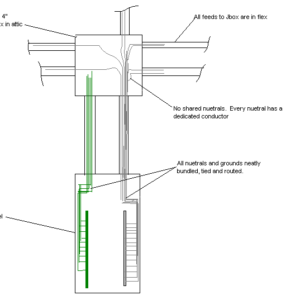
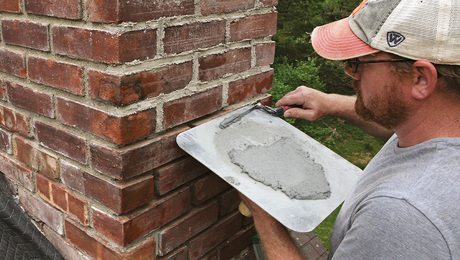

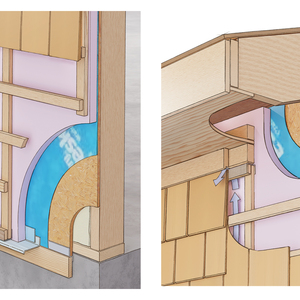
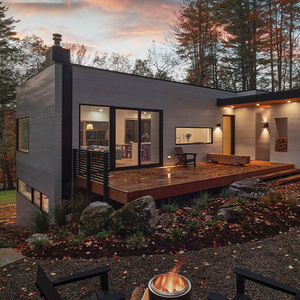

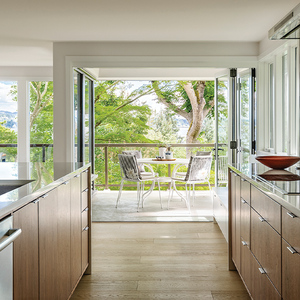













Replies
It would be nice for the neutrals to be ID'd. If you need to install GFCI's or AFCI's then you need to match the neutral to the hot as they both feed from the breaker and not the bus.
But I don't know that it is required.
But I see a serious problem with your plan. All raceways and conduits need to carry both the hot and neutral for a circuit.
.
Hey every group has to have one. And I have been elected to be the one. I should make that my tagline.
BillHartmann,
You've gotta be kidding me! Nuetral and hot conductors have to be in the same raceway even for the short (4 foot) run between the J-box and panel??
Do you happen to have the code reference? I'd like to read it to see if perhaps I have an exception for the conduit length.
Thanks!
Jim
Try the NEC [National Electrical Code], section300.3[b], 2005 edition.
"All conductors of the same circuit and, where used, the grounded conductor and all equipment grounding conductors and bonding conductors SHALL be contained within the same raceway, auxiliary gutter, cable tray,cablebus assembly,trench,cable or cord unless otherwise permitted in accordance with 300.3[B][1] through [B][4]'
Note: grounded conductor refers to your neutral.
Also, only one ground wire would be required, sized according to the size of the largest breaker on your circuits.
Chuck
I can think of a couple possible reasons for this:
1. To prevent eddy currents in metal conduit and boxes.
2. To prevent confusion as to which neutral goes with which hot.
Are either or both the real reason this is in the code?
-- J.S.
#1, I think. Heating will occur in any metal between the conductors.
I say,"I think", because I'm not an engineer.
I deal more with the issues of "can we do this" rather than with the " why can't we".
After a few years[ over thirty five in the trade for me], I learned to concentrate my efforts in getting my jobs code compliant . I didn't have time to worry about the engineering"why".
Chuck
Chuck had the code section.But what you have with the junction box, two section of conduit and CB panel makes a nice single turn transformer secondary, if they are all metal. No problem in that if you don't have a primary.But with the all of the hots in one side and neutrals in the other the currents through it make a nice single turn primary..
.
Hey every group has to have one. And I have been elected to be the one. I should make that my tagline.
The one code requirement I think you may need to look at is that the hot and neutral for each circuit have to be in the same conduit. Labeling in the panel which neutral goes with which circuit isn't required, or even worth doing. But if you add on to this by splicing in a box someplace else, you absolutely must use the neutral that goes with the hot you're using. You can't just grab any neutral that's handy.
-- J.S.
I think you should try to make the attach file larger, it's much to small and loads far too quickly.
Looks good from the street, does it work?
I'm in the process of doing the same thing you are. One thing I'll point out though, you don't need all those ground connections going up to the J-box. All you need is one big one, same size as you main ground line, and run it up to an added in bus bar attached to the back of the J-box. Now you just have to worry about running up black/reds and whites.
With the new requirements on AF and GFI circuits, I just ran up black and white pairs, labled on each end with the breaker position it was using.
Rebuilding my home in Cypress, CA
Also a CRX fanatic!
Be sure to keep your grounds and neutrals seperate in the subpanel and use an insulated neutral bus bar, untill the main panel where the neutrals can be grounded to the panel box directly.